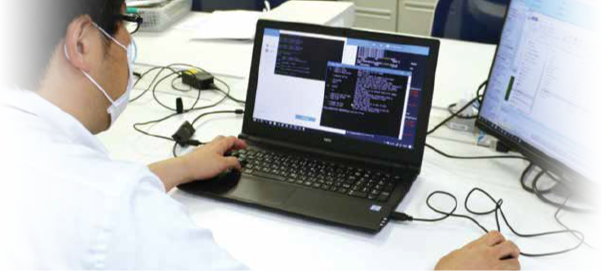[Foundation Strategies]
ICT Strategy
[Foundation Strategies]
ICT Strategy
[Foundation Strategies]
ICT Strategy

The Company has defined the approach to create a next-generation construction system that uses digital technologies as Vision 2030. We drive the digitalization of design/construction plans and construction sites and the use of digital data collected and accumulated from the plans and sites.

3D design/construction plans based on BIM/CIM, and cost estimate, analysis and simulation using the 3D design/construction plans
Recognition codes, sensors and systems to connect BIM-based design/construction plans to construction sites and bridge the gap between them
Mechanism to link data collected and accumulated from BIM-based design/construction plans to data from construction sites and to use such data
Next-generation construction system which connects construction sites that are digitalized with ICT, including IoT, AI and robotics, to 3D design/execution plans

Focusing on Vision 2030 that the Company is aiming for, we are working to create a next-generation construction system, the SMile Construction System. It is an evolution of the mutual civil engineering/building construction total construction management system, DCM (Japanese only) (DIM/CIM/MIM)®.* BIM/CIM is the foundation for this next-generation construction system. A 3D design/construction plan is linked to a digitalized construction site that incorporates ICT, such as IoT, AI, and robotics. Without this, we can’t hope to raise the efficiency and productivity of design and construction.
We plan to improve productivity, safety, and quality by using BIM/CIM linked with ICT. Consensus with customers can be built quickly by the visualization effect of a BIM model. Also, they can enjoy major advantages, such as confirming ongoing construction or construction completion at an early project stage. The Company is proactively promoting BIM/CIM applications through domestic and overseas civil engineering/ building construction.
We are consistently using BIM (Japanese only) for planning, construction, and maintenance management, building mutual understanding among persons involved in the project through front loading, and striving to improve productivity and maintain quality.
We are using robotics and the automation of the PCa manufacturing process using BIM data, linking data between the manufacturing plant and the manufacturer, and striving to improve productivity and maintain quality.
We are promoting the automation of construction machinery using BIM data, inspections linked to all types of ICT and management optimization, striving to improve productivity, reduce accidents to zero, and maintain quality.
By introducing and expanding use of the latest digital technology (such as RPA and AI) in existing business processes, we are promoting work style reforms and the business optimization of the entire company through creating an environment that can make possible secure smart work.
Specifically, we are carrying out an update of the core system as per the mid- to long-term IT plan and switching over to a next-generation system. Through strategic introduction next-generation standards, thin clients, and mobile devices, we are creating an environment which safely makes possible diverse work styles. Also, we are striving to establish infrastructure and improve business systems at overseas positions, upgrading the global network.
We have created an environment necessary for employees to telework for the purpose of reducing the number of people going to the office due to the spread of COVID-19 infection. Specifically, we introduced mobile devices, a business chat tool, a remote learning system, online meeting system, and other tools.
As the business chat tool is easy to use for reports, communication and consultations and enables to send information to all people involved at once, all employees use the tool in daily operations, and it has become common as one of our communication tools in addition to email and phone. We introduced the remote learning system (video learning platform) to provide training and education programs for talent development. The system allows employees to watch videos of various internal training programs and about messages from the management in an easy-to-understand way even under the telework environment, and this brings great learning effects.
We introduced RPA in fiscal 2019, and more than 40 robots operate now. In addition to reducing work hours, RPA has delivered many positive effects. Being freed from routine work lightens the mental burden, information can be received in real time, and processing work for massive quantities of data, which people found conventionally difficult to carry out, was made possible. In fiscal 2020, we started introducing RPA in group companies, seeking to optimize business duties across the Group. We will strive to further increase efficiency by expanding the scope of application and training some employees as developers.
Currently, the use and application of information communication technology (ICT) is advancing in companies. Going forward, this era will see radical changes in business and society by using digital technology (digital transformation) and major shifts in work styles. On the other hand, targeted cyberattacks aimed at governments and companies are growing more sophisticated every year. Going forward, continuous countermeasures against increasingly diversified and complex threats to information security will be imperative. The Company continuously acquires the external certification of ISO27001 (ISMS) and takes measures to conform to the requirements.
However, we confirmed in December 2020 that an external third party gained unauthorized access to part of data related to our sites (including personal information). We have several external data backup systems to store business data used in our sites. One of our subcontractors had partly vulnerable access settings in one of the data backup systems, and this allowed unauthorized access. We deeply apologize for causing a great deal of concern and inconvenience to all relevant parties in this regard.
After this incident, we set up the Information Security Management Office, an organization dedicated to information security, to 1) ensure system security, 2) ensure reliability in operating the data storage systems, and 3) take stricter measures to manage personal information and confidential information by developing a system that constantly diagnoses and monitors the systems.